What is an AFCI (Arc Fault Circuit Interrupter) and How Does it Work?
Each year thousands of people get injured and hundreds of people die due to accidents associated with electrical wiring. The faults generated in electrical wires can cause serious injuries to any person and damages to the property if they are left unattended. An arc fault is one of the main causes of an electrical fire in the home. NEMA (National Electrical Manufacturers Association) requires installing AFCI in your homes and building to prevent the electrical fires caused by arc faults.
What is an Arc Fault?
An arc fault is a powerful electrical discharge between two or more than two conductors. The arc can vary in strength that depends on its current ratings and duration. It can generate enough heat to break the insulation and cause an electrical fire. The arc also generates waveforms that can disrupt or destroy sensitive electronics equipment.
Related Post:
- GFCI: Ground Fault Circuit Interrupter. Types, Working and Applications
- Difference Between GFCI and AFCI
Types of Arc Faults
The arc fault can happen in two ways therefore, they are divided into two types.
Parallel Arc Fault
The parallel arc fault occurs between two different conductors or wires due to broken insulation or a small gap between them. It occurs between two phases or phase to neutral.
Series Arc Fault
The series arc fault occurs in the same conductor in series with the load due to damage or loose connection between them.
Out of the two of these arc faults, the most dangerous arc fault is the parallel arc fault.
Related Posts:
- How to Wire an AFCI Outlet? – Arc Fault Interrupter Outlet Wiring
- How to wire a GFCI Outlet? – GFCI Wiring Circuit Diagrams
Causes of Arc Fault
The arc fault can occur due to many reasons. Here are some of the causes of arc fault;
- Loose Wire Connection: The screw terminals that are loosely connected on the wall outlets may touch other wires and cause arc fault. It can also get loose due to frequent plugging and pulling.
- Overheated Wires: Heat can break down the insulation around the wire or the conductor itself creating a small gap between them. The current jumps through the gap creating an arc fault.
- Damaged Wires: the wires may get damaged due to various reasons such as nailing on the walls for hanging pictures etc. with wires behind them, kinking or twisting of wires, pushing furniture against the cord can pierce the insulation causing arc fault
- Damaged terminals: The terminals and wires may get corroded due to excessive use that reduces its efficiency.
- Liquid Near Electrical tools: Liquids such as water can also be cause of arc fault in a circuit.
What is an AFCI?
AFCI stands for Arc Fault Circuit Interrupter (aka AFDD = arc-fault detection device). It is a protective device used for protection against fire hazards caused by arc faults. The Arc Fault Circuit Interrupter can detect arcs in the circuit and break the supply of electrical power to the said circuit.
AFCI also provides protection against overloading and short circuit current using thermal and magnetic protection as used in a normal circuit breaker.
The following fig shows the basic construction and labels for Arc fault circuit breakers and Outlet.
Good to Know:
- According to NEC 2014, AFCI protection is must in all new construction, dormitories and dwelling units, bedrooms, living rooms and other similar locations in residential areas.
- AFCI and GFCI should not be installed with life saving and other sensitive equipment (like in Hospitals and ICU etc. where continuous power supply is must for proper operations) that lost power.
- An AFCI and GFCI can be used on the same circuit as they don’t interfere with each other. You may use the combo of both AFCI/GFCI for the purpose as well.
- It’s must to know the Line and Load terminals of an AFCI outlet. The load must be connected to the load terminals of AFCI outlet to be protected by AFCI. Any load connected to the line terminals of AFCI are not AFCI protected as they are connected to the direct main supply.
- To avoid false tripping operation, do not install and wire an AFCI, GFCI, GFPE (Ground Fault Protection of Equipment) or Combo of both AFCI/GFCI circuit breakers on shared Neutral wire with other circuits.
Functions of AFCIs
Apart from protection against overload and short circuits, AFCI’s main function is protection against arc faults.
An AFCI has three following functions;
- Arc Fault Protection: The main purpose of Arc Fault Circuit Interrupter is to protect against the damages caused by arcing.
- Overload Protection: Overloading occurs when the current exceeds a certain limit for a prolonged duration. The overloading current generates heat that can damage the equipment, wirings and can create fire hazards. AFCI can protect a circuit from overloading current using a bimetallic thermal strip.
- Short Circuit Protection: When phase wire comes in contact with each other or neutral. There is a huge amount of current that is very destructive. AFCI can also protect from short circuit conditions using a thermal relay.
Related Posts:
- How to Wire an AFCI Breaker? Arc Fault Circuit Interrupter Wiring
- How to Wire a GFCI Circuit Breaker? 1, 2, 3 and 4 Poles GFCIs Wiring
Operation of an AFCI Breaker
The AFCI continuously monitors the main current for the presence of arc waveform and the arcing current magnitude. If the arc is dangerous, it interrupts the current supply to the load to prevent any further damage.
The Arc fault interrupter also includes the thermal and magnetic tripping mechanism of a conventional circuit breaker. The thermal mechanism includes a bimetallic strip that bends with high temperature due to overloading current and actuates the latch to break the circuit. While the magnetic mechanism includes an electromagnetic relay that breaks the circuit in case of short circuit current.
The AFCI includes logic circuits that can detect the arc waveform. It can differentiate between normal and unwanted waveforms. Normal arcs is low-level small arcs often generated during switching and plugging wires into socket. The unwanted faulty arc has a non-periodic waveform having discontinuities and current spikes. There are different methods used for detecting dangerous waveforms and new efficient techniques are still devised till this day. The arc fault circuit interrupter has a waveform filtering circuit that filters the waveforms from the main current.
The waveform is magnified by the amplifier circuit and fed to a logic circuit. The logic circuit based on various waveform detection techniques detects if the arc waveform is dangerous and breaks the contact.
The test button is used for checking if the AFCI is working properly. It generates a waveform that simulates the arcing conditions. If the device is working properly, it will break the circuit.
Related Posts:
- How to Wire an AFCI Combo Switch – AFCI Switch Wiring Diagrams
- How to Wire GFCI Combo Switch and Outlet – GFCI Switch/Outlet Wiring Diagrams
Types of AFCIs
There are different types of Arc fault circuit interpreters that depend on the type of its application.
Combination AFCI
Combination AFCI provides protection against both parallel and series arc fault. The parallel arc occurs between phase to phase, phase to neutral and phase to ground. While the series arc occurs along the same conductor.
They are the most used arc fault circuit interrupters in the main distribution panels to protect the branch circuit including the loads connected to it.
Dual-Function AFCI
The dual function AFCI is a device that offers protection against both arc-fault and ground faults. It has both the function of AFCI and GFCI. Therefore, it is the most reliable protection device and to be used at home. It is also cheaper and takes less space than using individual AFCI and GFCI.
Branch / Feeder type AFCI
The branch or feeder type AFCI is the oldest arc fault circuit breaker that is used at the start of a branch circuit or feeder at the distribution panel. It protects against only parallel arc faults in the connected branch circuit i.e. phase to phase, phase to neutral, phase to ground.
Such AFCI is no longer in use and have been replaced by a combination of AFCI
AFCI Outlet / Receptacle
It is an outlet included with an AFCI protection circuit. It offers protection against arcing to appliances, power cord and cables connected to the said outlet.
Portable AFCI
It is a plug-in device like an extension cord with an AFCI plug that is plugged into any normal outlet/receptacle (that has no AFCI protection). The portable AFCI provides protection to any appliances or load connected to it.
Advantages and Disadvantages of AFCIs
Advantage
Here are some of the advantages of Arc fault circuit interrupters
- The AFCI can differentiate between the normal and unwanted arc.
- It helps in the prevention of damage and injuries caused by electrical fires.
- It also offers protection against overcurrent.
- It is more efficient than a standard circuit breaker.
- It can protect the while branch circuit from arc faults.
Disadvantages
Here are some of the disadvantages of Arc fault circuit interrupters
- AFCI is expensive than a conventional circuit breaker
- It cannot stop the first arc.
- It has a more complex design and structure.
Applications of AFCIs
50% of the electrical fires are caused by arcing. Therefore, the Arc fault circuit interrupter is used to break the circuit during arcing to prevent any damage. The NEC also requires that all the receptacles installed in a dwelling bedroom must be protected with AFCI. This includes all receptacles even including the bathroom and kitchen etc.
Related Posts:
- Types of Circuit Breakers – Working and Applications
- Air Circuit Breaker: Construction and Operation
- MCB (Miniature Circuit Breaker) – Construction, Working, Types and Uses
- MCCB (Molded Case Circuit Breaker) – Construction, Types and Working
- Difference between MCB, ELCB, RCBO and RCD Circuit Breakers
- HRC Fuse: Construction and Operation
- Resistor and Types of Resistors
- Fuse and Types of Fuses
- Types of Switches

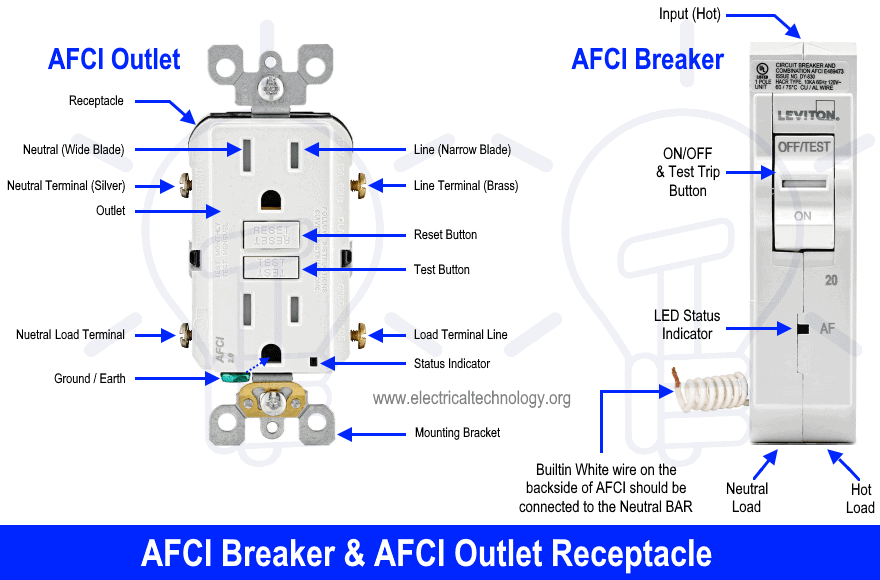
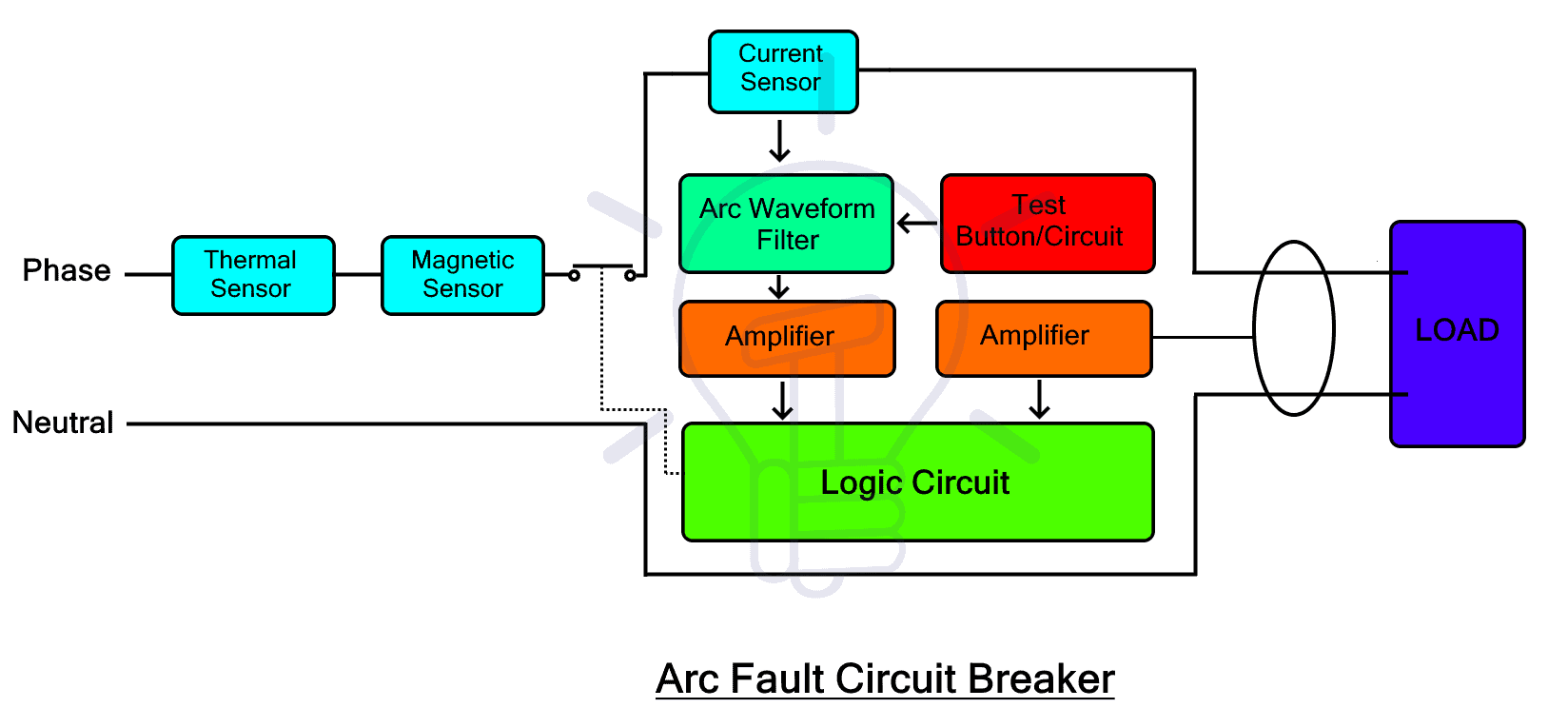
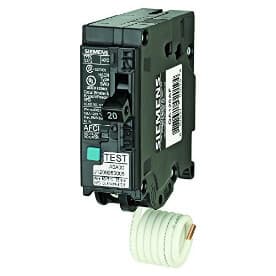
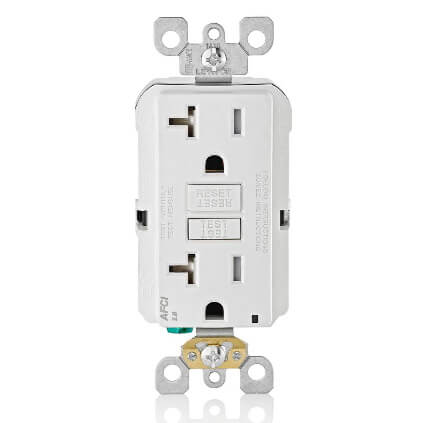
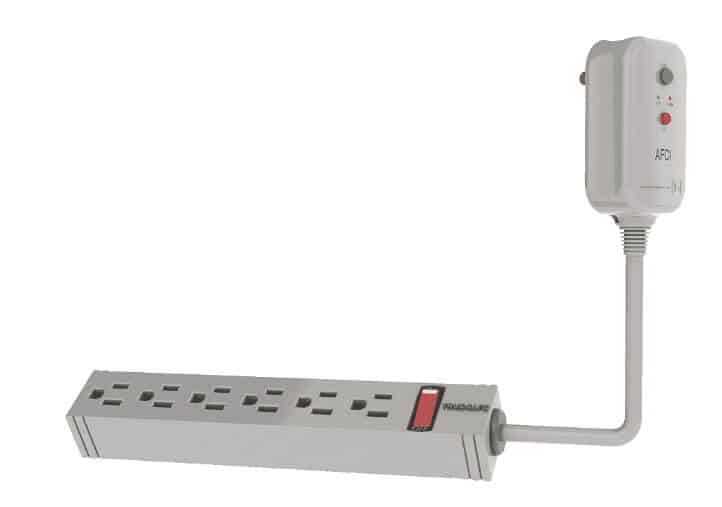
 Why Does an Electric Tester Not Work in DC Circuits?
Why Does an Electric Tester Not Work in DC Circuits? Why Do The Positive And Negative Wires Spark When Touched?
Why Do The Positive And Negative Wires Spark When Touched? What are the Cuts on the Rotor of Motor’s Armature?
What are the Cuts on the Rotor of Motor’s Armature? Why Don’t Bug Zappers and Fly Swatter Bats Kill Humans?
Why Don’t Bug Zappers and Fly Swatter Bats Kill Humans? Why Use VCB Circuit Breakers in HV Transmission, & Not ACB?
Why Use VCB Circuit Breakers in HV Transmission, & Not ACB?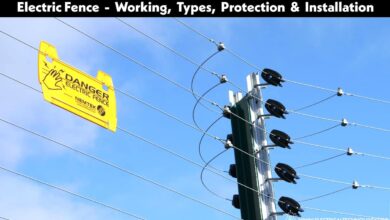 Electric Fence – Working, Types, Protection & Installation
Electric Fence – Working, Types, Protection & Installation